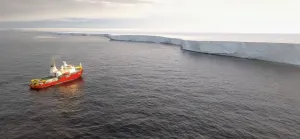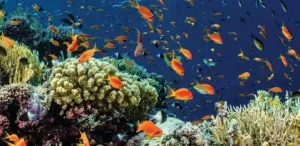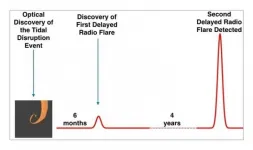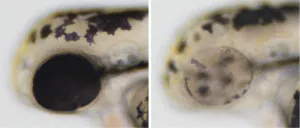INFORMATION:
Further information
The research team led by the University of Leeds included colleagues from Swansea University, Colombia University, British Antarctic Survey, ENVEO IT GmbH, Remote Sensing Technology Institute in Germany, University of Denmark, University College London and Korea Polar Research Institute.
The study, Widespread increase in dynamic imbalance in the Getz region of Antarctica from 1994 to 2018, is published 19 February 2021 in Nature Communications. DOI: 10.1038/s41467-021-21321-1
Researchers in this study were supported by various grants. Anna E. Hogg was supported by the NERC DeCAdeS project (NE/T012757/1) and ESA Polar+ Ice Shelves project (ESA-IPL-POE-EF-cb-LE-2019-834). Pierre Dutrieux was supported by NSF awards 1643285, 1644159, and a Columbia University Climate and Life Fellowship. Tae-Wan Kim from the Korea Polar Research Institute, grant KOPRI PE20160.
Getz ice shelf photo credit : Pierre Dutrieux
For further details, contact Ian Rosser in the University of Leeds press office via i.rosser@leeds.ac.uk
Glaciers accelerate in the Getz region of West Antarctica
2021-02-23
(Press-News.org) Glaciers in West Antarctica are moving more quickly from land into the ocean, contributing to rising global sea levels. A 25-year record of satellite observations has been used to show widespread increases in ice speed across the Getz sector for the first time, with some ice accelerating into the ocean by nearly 50%.
The new study, led by the University of Leeds, reports that 14 glaciers in the Getz region are thinning and flowing more quickly into the ocean. Between 1994 and 2018, 315 gigatonnes of ice has been lost, adding 0.9 mm to global mean sea level - equivalent to 126 million Olympic swimming pools of water.
The results published today (19/02/2021) in the journal Nature Communications show that, on average, the speed of all 14 glaciers has increased by almost a quarter with three glaciers' speeding up by over 44 %. This research will help scientists determine whether glaciers in the region may collapse in the next few decades and how this could affect future global sea-level rise.
Heather Selley, lead author of the study and a glaciologist at the Centre for Polar Observation and Modelling at the University of Leeds, said: "The Getz region of Antarctica is so remote that humans have never set foot on most of this part of the continent. Satellite radar altimetry records have shown substantial thinning of the ice sheet.
"However, the high rates of increased glacier speed - coupled with ice thinning - now confirms the Getz basin is in 'dynamic imbalance', meaning that it is losing more ice than it gains through snowfall.
"Using a combination of observations and modelling, we show highly localised patterns of acceleration. For instance, we observe the greatest change in the central region of Getz, with one glacier flowing 391 m/year faster in 2018 than in 1994. This is a substantial change as it is now flowing at a rate of 669 m/year, a 59% increase in just two and a half decades."
The research, funded by the Natural Environment Research Council (NERC) and the European Space Agency (ESA), reports how the widely reported thinning and acceleration observed in the neighbouring Amundsen Sea glaciers, now extends over 1,000 km along the West Antarctic coastline into Getz.
Dr Anna Hogg, study co-author and climate researcher in Leeds' School of Earth and Environment said: "The pattern of glacier acceleration shows the highly localised response to ocean dynamics.
"High-resolution satellite observations from satellites such as ESA's Sentinel-1, which collects a new image every six-days, means we can measure localized speed changes with ever greater detail.
"Consistent and extensive sampling of both ice speed and ocean temperature are needed to further our understanding of the dynamic ice loss, which now accounts for 98.8 % of the Antarctica's sea level contribution."
By examining 25 years of ocean measurements, the research team were able to show complex and annual variations in ocean temperatures. These results suggest that the "dynamic imbalance" is mainly caused by longer-term ocean forcing, where increased heat content in the ocean is interacting with the ice and enhancing melt.
Pierre Dutrieux, study co-author and climate researcher at British Antarctic Survey, said: "We know that warmer ocean waters are eroding many of West Antarctica's glaciers, and these new observations demonstrate the impact this is having on the Getz region.
"This new data will provide a new perspective of the processes taking place so we can predict future change with more certainty."
ELSE PRESS RELEASES FROM THIS DATE:
High energy radiotherapy could 'paint' tumours to avoid harming healthy tissue
2021-02-23
A radiotherapy technique which 'paints' tumours by targeting them precisely, and avoiding healthy tissue, has been devised in research led by the University of Strathclyde.
Researchers used a magnetic lens to focus a Very High Electron Energy (VHEE) beam to a zone of a few millimetres. Concentrating the radiation into a small volume of high dose will enable it to be rapidly scanned across a tumour, while controlling its intensity.
It is being proposed as an alternative to other forms of radiotherapy, which can risk non-tumorous tissue becoming overexposed to radiation.
The researchers are planning further investigation, with the use of a purpose-built device.
The study ...
'Missing ice problem' finally solved
2021-02-23
During glacial periods, the sea level falls, because vast quantities of water are stored in the massive inland glaciers. To date, however, computer models have been unable to reconcile sea-level height with the thickness of the glaciers. Using innovative new calculations, a team of climate researchers led by the Alfred Wegener Institute has now managed to explain this discrepancy. The study, which was recently published in the journal Nature Communications, could significantly advance research into our planet's climate history.
During transitions from glacials to interglacials, the glaciers on Greenland and in North America and Europe wax and wane ...
Microbiome boost may help corals resist bleaching
2021-02-23
A simple but powerful idea is to improve the health of corals using cocktails of beneficial bacteria. The strategy is being explored as part of global scientific efforts to help corals become stronger, more stress resistant and more likely to survive bleaching events associated with climate change.
Corals rely on bacterial and algal symbionts to provide nutrients, energy (through photosynthesis), toxin regulation and protection against pathogenic attacks. This complex and finely balanced relationship underpins the health of the holobiont and coral reefs as a whole.
Rather like the use of probiotics in plant science to improve ...
How women, migrants and workers are represented in the German Bundestag
2021-02-23
Members of the German Bundestag who belong to underrepresented groups are more active in the legislative process and, early on, typically tend to advocate more for the interests of their groups. However, a current study by the universities in Konstanz, Basel, Geneva and Stuttgart indicates that, after a few years, most of them do move on to other political fields. This is tied to the career-related incentives these elected representatives face: At first, their careers in parliament benefit from their ability to speak for underrepresented groups. As their careers progress, however, they are required to demonstrate expertise in areas beyond the interests of these groups, the researchers conclude.
The study was led by Professor Christian Breunig, ...
Families have high awareness of healthy eating but struggle to access good food
2021-02-23
Low-income families have a high awareness of healthy diets but can't afford good quality and nutritious food, new research shows.
The University of York study, in partnership with N8Agrifood, showed that participants tried to eat as much fruit and vegetables as they could within financial constraints, avoiding processed food wherever possible. But there was widespread acknowledgement that processed food was often more accessible than healthy options because of its lower cost.
The researchers said that while the diets of low-income households have been subject ...
For students of color, online racism leads to real-world mental health challenges
2021-02-23
Whether it's a "Zoombomb" filled with racial slurs, a racist meme that pops up in a Facebook timeline, or a hate-filled comment on an Instagram post, social media has the power to bring out the worst of the worst.
For college students of color who encounter online racism, the effect of racialized aggressions and assaults reaches far beyond any single social media feed and can lead to real and significant mental health impacts - even more significant than in-person experiences of racial discrimination, according to a recently published study from researchers at UConn and Boston College.
"I think we all suspected that we would find a relationship between the racism online in social media and student mental health," says lead author Adam McCready, an assistant professor-in-residence ...
ET phones home!
2021-02-23
A team of researchers from the Hebrew University of Jerusalem (HUJI) led by Dr. Assaf Horesh have discovered the first evidence of radio flares emitted only long after a star is destroyed by a black hole. Published in the periodical Nature Astronomy, the discovery relied upon ultra-powerful radio telescopes to study these catastrophic cosmic events in distant galaxies called Tidal Disruption Events (TDE). While researchers had known that these events cause the release of radio flares, this latest discovery saw those flares being emitted months or even years after the stellar disruption. The team was led by Dr. Horesh from the Racah Institute of Physics at the Hebrew together with the NASA Swift space telescope director Professor Brad Cenko and Dr. Iair ...
For selenium in rivers, timing matters
2021-02-23
Selenium contamination of freshwater ecosystems is an ongoing environmental health problem around the world. A naturally occurring trace element, selenium levels are high in some geologic formations like sedimentary shales that form much of the bedrock in the Western United States. Soils derived from this bedrock, and weathering of shale outcrops, can contribute high levels of selenium to surrounding watersheds.
New research out today in Environmental Science & Technology from UConn Assistant Professor of Natural Resources and the Environment Jessica Brandt with Travis Schmidt and colleagues at the United States Geological Survey (USGS) investigates some of the complexities of selenium and how it moves through the ecosystem during runoff ...
Cre-controlled CRISPR: Conditional gene inactivation just got easier
2021-02-23
To discover the function of a gene researchers turn it off and observe the consequences. Often genes have multiple functions that differ depending on a tissue and age. Some genes are essential to growth and turning them off too early can have profound consequences that can make observing other functions impossible. To avoid it, researchers have been using conditional gene inactivation which allows turning a gene off only in a specific tissue or later in development, e.g., in adulthood.
One of the systems used for conditional gene inactivation is Cre/lox. "It is the gold standard for the conditional gene inactivation in mice but over time has also become quite important in other model ...
Spintronics: New production method makes crystalline microstructures universally usable
2021-02-23
New storage and information technology requires new higher performance materials. One of these materials is yttrium iron garnet, which has special magnetic properties. Thanks to a new process, it can now be transferred to any material. Developed by physicists at Martin Luther University Halle-Wittenberg (MLU), the method could advance the production of smaller, faster and more energy-efficient components for data storage and information processing. The physicists have published their results in the journal "Applied Physics Letters".
Magnetic materials play a major role in the development of ...




